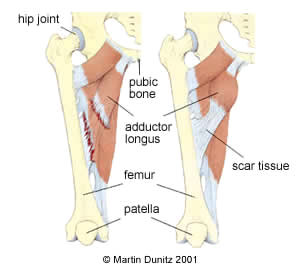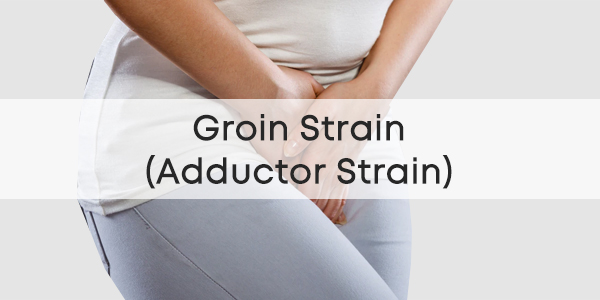What is a Groin Strain Injury?
A groin strain (adductor strain) is one of the most common injuries in sports, especially football. Moving the leg through a large range of movement such as kicking means sports like judo, karate and rugby can also hold a high risk. Running through particularly muddy ground or on a slippery surface can also predispose to groin strains. The term describes a strain of the adductor muscles that are located on the inside of the thigh. The adductor muscle group is made up of five muscles:
- Adductor brevis
- Adductor longus
- Adductor magnus
- Gracilis
- Pectineus

The injury usually occurs when the muscle is forcibly stretched beyond its limits and the muscle tissue tears. If the adductor muscles are overused to compensate for weak muscles they can also become prone to injury. A tear in a muscle is referred to as a strain and, depending on its severity, is classified as a first, second or third degree strain:
- First degree strain is damage to a few muscle fibres
- Second degree strain is damage to a more extensive number of muscle fibres
- Third degree strain is a complete rupture of the muscle itself
Signs & Symptoms of Groin Strain
In the case of a grade one groin strain the signs may not be present until after the activity is over. There may be a sensation of cramp or tightness and a slight feeling of pain when the muscles are stretched or contracted. Tightness may be felt first thing in the morning when getting out of bed or moving after a period of prolonged sitting then ease off with movement.
A grade two groin strain causes immediate pain which is more severe than the pain of a grade one injury and produces pain on walking. It is confirmed by pain on stretch and contraction of the muscle. A grade two groin strain is usually sore to touch.
A grade three strain is quite rare in the adductor muscles. There is an immediate burning or stabbing pain and the athlete is unable to walk without pain. In the case of grade two and three injuries, a large bruise will appear below the injury site after a few days – this is caused by bleeding within the tissues.
Groin Strain Treatment
The immediate treatment for any muscle injury consists of rest, ice, and compression. Ice packs can be applied for periods of twenty minutes every couple of hours (never apply ice directly to the skin as it can cause an ice burn). The ice packs relieve pain and reduce bleeding in the damaged tissue. This can help to reduce the injury rehab time.
Resting may be the common sense approach, but it is one that is often ignored by competitive athletes. This is unwise, since it does not take much to turn a grade one strain into a grade two, or a grade two strain into a grade three. As a general rule, grade one groin strains should be rested from sporting activity for about 3 weeks, and grade two injuries for about 4 to 6 weeks. Explosive movements such as sprinting and jumping in particular should be rested. With a grade one strain, gentle exercise such as walking or jogging may be possible.
In the case of a complete rupture an opinion from an orthopaedic doctor is required. The torn muscle may have to be repaired surgically and the rehabilitation afterwards will take about 3 months.
Groin Strain Prevention
The following measures may have the effect of reducing the chances of sustaining a muscle strain.
- Wear compression shorts to maintain muscle temperature
- Warm up before sporting activities
- Cool down following sporting activities
- Use a swiss ball for core strengthening exercises
- Replenish carbohydrates during sporting activity with energy bars & gels
Warm up prior to matches and training is thought to decrease muscle stretch injuries because the muscle is more extensible when the tissue temperature has been increased by one or two degrees. Compression shorts are extremely effective at maintaining muscle temperature, even in cold conditions. They provide warmth and support and are extremely effective at preventing muscle injuries.
A good warm up should last at least 20 minutes – starting gently and finishing at full pace activity, including changes of direction to target the adductor muscle group. Practicing sport specific activities helps tune coordination and prepare mentally for competition.
Recovery after training sessions and matches can be enhanced by performing a cool down. Ideally the cool down session should take place the day after the activity. This is thought to help muscles get rid of waste products. This is also the ideal time to do stretching exercises, gently stretching the groin muscles can help reduce stiffness the following day.
Maintaining good muscle strength and flexibility may help prevent muscle strains. Muscle strength allows a player to carry out match activities in a controlled manner and decreases the uncoordinated movements which can lead to injury. Core strength exercises using a swiss ball are ideal. Tight muscles are associated with strains and stretching on a mat should also be practiced to maintain muscle length and prevent injury. An imbalance often exists where the adductor group are overworked due to weaker gluteal muscles or sometimes to substitute for weak hip flexor muscles. A Physiotherapist assessment will help identify such imbalances and prescribe exercises to provide long term injury prevention.
Diet can have an effect on muscle injuries. If a player’s diet is high in carbohydrate in the 48 hours before a match there will be an adequate supply of the energy that is necessary for muscle contractions. However, if the muscles become short of fuel, fatigue can set in during training or matches. This fatigue can predispose a player to injury. Carbohydrate and fluids can be replenished during training and matches by taking an energy drink or energy gel periodically during activity.


